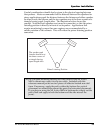
Speaker Installation
M1 Active Mk2 Reference Manual 17
CHAPTER 2
SPEAKER INSTALLATION
Like any speaker system, your M1 Active Mk2 speakers will work best when
properly positioned in a suitable acoustic environment. Achieving proper
speaker placement is usually straightforward, but even with nearfield
monitors, speaker placement and the acoustics of the listening room itself are
too often overlooked and can become significant contributors to an inaccurate
and uninspiring monitoring environment.
AVOIDING REFLECTIONS IN THE STUDIO
While nearfield monitors are more forgiving of the surrounding room
acoustics, it is always prudent to optimize the listening environment
whenever possible. First, the user should be aware of the effect that the size
of the listening room can have on low frequency response. In general, the
smaller the room, the stronger the bottom end will be, although placement
within a larger room can also make a difference. This has to do with the way
low-frequency waves travel in closed spaces. If you find your monitor
system to be either light or heavy on the bottom, try moving them around
within your listening room.
You should avoid locating your M1 Active Mk2s near reflective surfaces such
as glass, tile, large open walls or table tops. Still, many rooms used for
recording have these surfaces, so the best way to deal with them is to place
the monitors out in the room away from reflective walls, windows and
sizable objects. Even with these reflective surfaces separated from the
monitoring position, typical mixing situations usually still have the top
surface of the mixing board to deal with.
Unfortunately, the board itself can be a major source of reflections and the
additional acoustic conduction into the board can affect your monitor's
amplitude and phase response. Speaker placement on the console's meter
bridge allows two different acoustic paths between the speakers and the
recording engineer, which results in undesirable comb filtering effects and
poor imaging. The first path is the direct one, and the second is via a
reflection off the mixer main control panel:


















